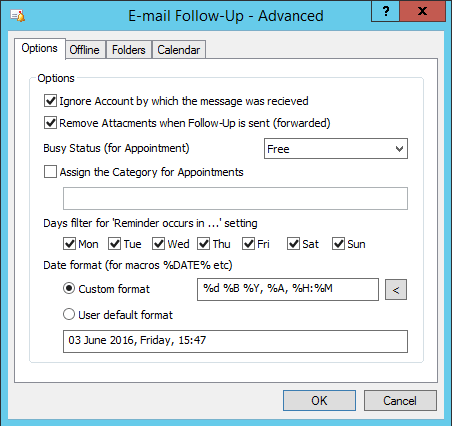

In the message list, click the message that you want. Start time of the first work day of next weekĬurrent date is displayed choose a custom date if desired
Outlook unreplied plus#
Start time of current day plus two work days Start time of current day plus one work dayĬurrent date plus two days, but no later than the last work day of this week One hour before the end time of today's work day The following default start dates, due dates, and reminder times are available for flags.

Use flags to mark items for follow-up and to include reminders. How do the flag dates on the Follow Up menu work? Ask yourself if you really need to interrupt the recipient with a reminder dialog box or if a flag is sufficient. Tip: Use discretion when adding a reminder to a flag for recipients. To add a reminder for recipients, check the Flag for Recipients box, and then enter the date and time you want the reminder dialog box to appear for the recipients. Reminders are alert dialog boxes that appear when follow up is due, just like you see for a meeting or appointment that’s about to start. This is the text the recipient will see above the From line.įor added visibility, you can include a reminder.

For example, you could type Send Anne an answer to the permit question. In the Custom dialog box, we recommend changing the default Flag to text to a description or action. If the recipient is also using Outlook, an item will be added to his or her to-do list. A flag appears in the message list and text appears above the From line in the message. Flag for recipientsĪ flag on a message to recipients adds extra emphasis. Enter the date and time for when you want the reminder dialog box to appear. To add a reminder for yourself, click Follow Up > Add Reminder. Reminders are alert dialog boxes that appear when follow up is due, just like the ones you see for upcoming meetings or appointments. Since the message will be out of sight in your Sent Items folder, we recommend you add a reminder for yourself.

By adding a flag, you’ll see a to-do item in Tasks and the Tasks peek.Ĭlick Today, Tomorrow, This Week, Next Week, No Date, or Custom. A flag to yourself lets you know that you asked others for a response. You want to make sure you don’t forget about the request and you get the information you need. If you’ve turned off all alerts in Outlook, you’ll still get an alert if you have a rule set up to do so.You’re sending a message that requires a response. When you set up a custom alert using a rule, it overrides the default alert permissions you’ve set up. We’ve covered rules in general previously, so have a quick look if you’ve never used them before. Microsoft Outlook lets you set up custom alert rules for specific email addresses or entire domains.
Outlook unreplied how to#
RELATED: How to Only Get Notifications for Emails You Care About on Your iPhone But what if you really need to know when an email arrives from your boss, a client, or someone else important to you? If email alerts from Outlook are distracting you, the easiest thing to do is to turn them off. Rather than getting alerts every time an email arrives, configure Microsoft Outlook to only alert you when the important stuff hits your inbox, rather than any old email that can wait until you check your inbox. Some emails are more important than others.


 0 kommentar(er)
0 kommentar(er)
